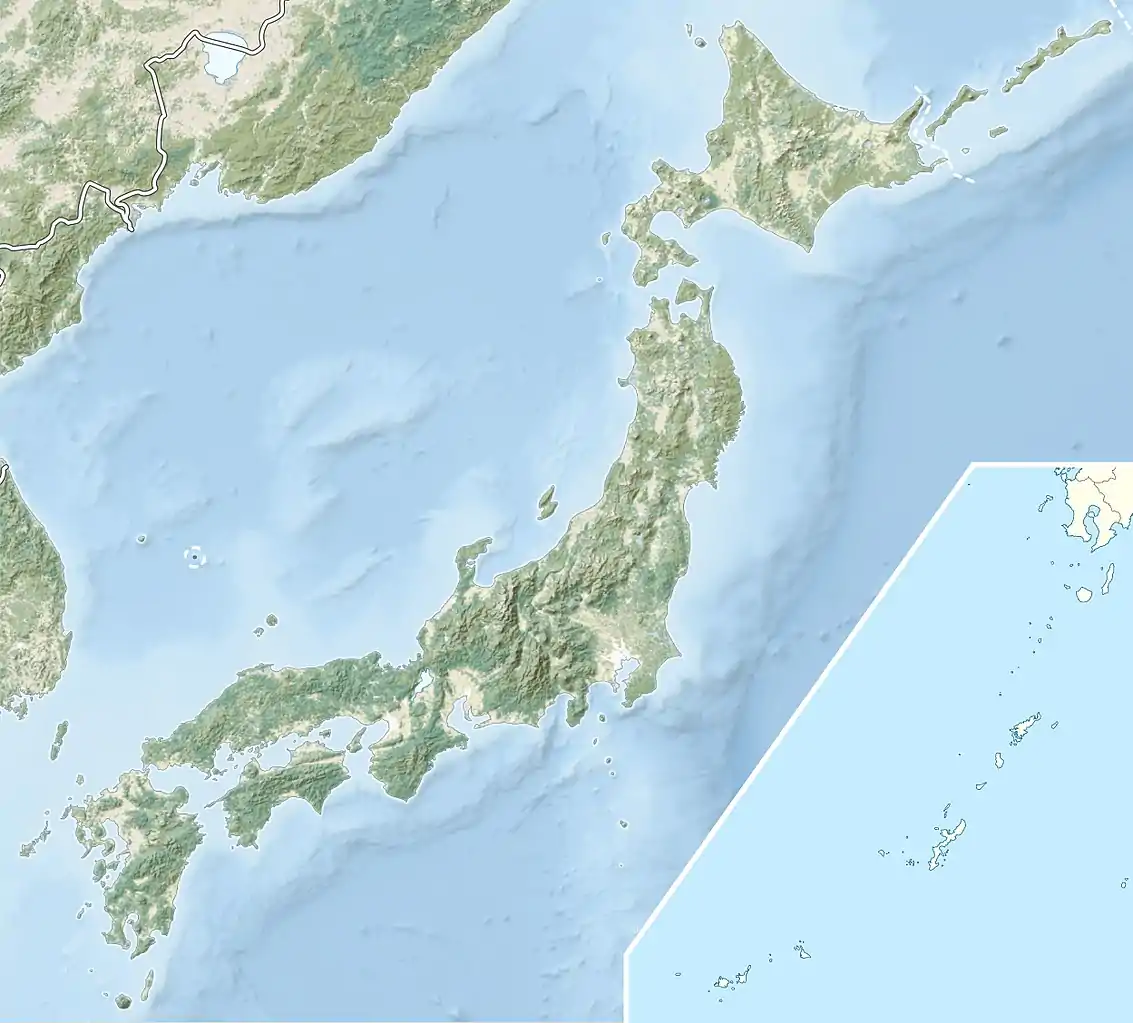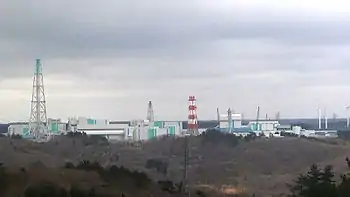Rokkasho Reprocessing Plant
The Rokkasho Nuclear Fuel Reprocessing Facility (六ヶ所村核燃料再処理施設, Rokkasho Kakunenryō Saishori Shisetsu) is a nuclear reprocessing plant with an annual capacity of 800 tons of uranium or 8 tons of plutonium.[1] It is owned by Japan Nuclear Fuel Limited (JNFL) and is part of the Rokkasho complex located in the village of Rokkasho in northeast Aomori Prefecture, on the Pacific coast of the northernmost part of Japan's main island of Honshu.

History

Construction of the plant began in 1993, and was originally expected to be completed in 1997, but the completion date has been postponed 23 times by 2017.[2][3]
Construction and testing of the facility were complete in 2013 according to JNFL, and the site was intended to begin operating in October 2013; however this was delayed by new safety regulations.[4][5] In December 2013 JNFL announced the plant would be ready for operation in October 2014.[6] In 2015, the start of the reprocessing plant was postponed again, this time to as late as September 2018.[7]
In December 2017, the completion date was put back a further three years, to 2021, to allow for further safety measures at the reprocessing plant and the MOX fuel fabrication plant to meet post-Fukushima safety standards.[2] The delays have caused many parts of the plant to deteriorate, and the closure of the unsuccessful fast breeder reactor at Monju in 2016 reduces the need for the policy of nuclear fuel reprocessing.[3] In August 2018 more corroded pipes were found.[8]
In 2018 the Japanese Atomic Energy Commission updated plutonium guidelines to try to reduce plutonium stockpiles, stipulating that Rokkasho should only produce the amount of plutonium required for mixed oxide fuel for Japan's nuclear plants.[9][10]
In 2020 the completion date was put back again to 2022, for further safety measures including construction of another cooling tower.[11]
Description
The Rokkasho plant is the successor to a smaller reprocessing plant located in Tōkai, Ibaraki in central Japan, which ceased operation in 2007.
The Rokkasho facilities complex includes:
- A high level nuclear waste monitoring facility
- A MOX fuel fabrication plant
- A uranium enrichment plant[12][13]
- A low level radioactive waste landfill
In 2010, the Rokkasho complex consisted of 38 buildings on an area of 3,800,000 m².[1]
Vitrification tests completed in November 2007. This consists of pouring high level dry waste residue along with molten glass into steel canisters.[14]
As of 2018, over a third of Japan's 10 metric tons of domestically held plutonium is stored at Rokkasho.[10]
Economic aspects
Since 1993 there has been US$20 billion invested in the project, nearly triple the original cost estimate.[15] A 2011 estimate put the cost at US$27.5 billion.[16]
Protests
In May 2006, an international awareness campaign about the dangers of the Rokkasho reprocessing plant, Stop Rokkasho,[17] was launched by musician Ryuichi Sakamoto. Greenpeace has opposed the Rokkasho Reprocessing Plant under a campaign called "Wings of Peace – No more Hiroshima Nagasaki",[18] since 2002 and has launched a cyberaction[19] to stop the project. Consumers Union of Japan together with 596 organisations and groups participated in a parade on 27 January 2008 in central Tokyo against the Rokkasho Reprocessing Plant.[20] Over 810,000 signatures were collected and handed in to the government on 28 January 2008. Representatives of the protesters, which include fishery associations, consumer cooperatives and surfer groups, handed the petition to the Cabinet Office and the Ministry of Economy, Trade and Industry.
Seven consumer organisations have joined in this effort: Consumers Union of Japan, Seikatsu Club Consumer's Co-operative Union, Daichi-o-Mamoru Kai, Green Consumer's Co-operative Union, Consumer's Co-operative Union "Kirari", Consumer's Co-operative Miyagi and Pal-system Co-operative Union.
'Experts including Frank von Hippel, a Princeton University theoretical physicist, have urged Japan to stop spent fuel reprocessing.', reported The Japan Times.[7] The fundamental objection to reprocessing—the separation of plutonium from spent power reactor fuel—is that the plutonium is a nuclear explosive. Despite nuclear industry claims to the contrary, it usable for powerful nuclear weapons.[21] A plant like Rokkasho can separate several tons of plutonium per year. a nuclear weapon requires only several kilograms.
2011 Tōhoku earthquake and tsunami
In June 2008, several scientists stated that the Rokkasho plant is sited directly above an active geological fault line that could produce a magnitude 8 earthquake. But Japan Nuclear Fuel Limited stated that there was no reason to fear an earthquake of more than magnitude 6.5 at the site, and that the plant could withstand a 6.9 quake.[22][23]
After the Tōhoku earthquake (magnitude 9.1) in March 2011, the plant ran on emergency power provided by backup diesel generators.[24] The emergency generators were not intended for long-term use.[25] Reportedly there are about 3,000 tons of highly radioactive used nuclear fuel stored in Rokkasho at the current time. Japanese radio reported on 13 March that 600 liters of water leaked at the Rokkasho spent fuel pool.[26] According to The New York Times, grid power was restored on 14 March 2011.[27]
The 7 April aftershock caused the loss of grid power again until the next day.[28][29]
See also
- Stop Rokkasho – Opposition group
- Rokkasho Rhapsody – A documentary by Hitomi Kamanaka on the plant
- Nuclear reprocessing; other reprocessing sites:
- 5 yen coin#Use in nuclear accident investigation
- Tōkai Nuclear Power Plant, whose reprocessing facility Rokkasho was meant to succeed to
- Lists of nuclear disasters and radioactive incidents
References
- Heinonen, Olli J. (June 2010). "Safeguards in action: IAEA at Rokkasho, Japan" (PDF). Retrieved 13 March 2011.
- "Further delay to completion of Rokkasho facilities". World Nuclear News. 28 December 2017. Retrieved 28 December 2017.
- "Japan closes Ohi 1&2 and Monju". Nuclear Engineering International. 29 December 2017. Retrieved 29 December 2017.
- Japan's Nuclear Plan Unsettles U.S.
- http://www.jnfl.co.jp/english/topics/131219-1.pdf
- "Work on Rokkasho fuel reprocessing plant to be 'completed' by October". The Japan Times. 20 December 2013. Retrieved 23 December 2013.
- Yamaguchi, Mari (17 November 2015). "Fuel reprocessing plant in northern Japan delayed again, to 2018". The Japan Times. Associated Press. Retrieved 29 December 2017.
- "More problems for Japan's Rokkasho reprocessing plant". Nuclear Engineering International. 4 September 2018. Retrieved 9 September 2018.
- "Japan revises plutonium guidelines". Nuclear Engineering International. 2 August 2018. Retrieved 2 August 2018.
- Rich, Motoko (22 September 2018). "Japan Has Enough Nuclear Material to Build an Arsenal. Its Plan: Recycle". New York Times. Retrieved 29 September 2018.
- "Japanese reprocessing plant delayed by another year". World Nuclear News. 25 August 2020. Retrieved 25 August 2020.
- "Uranium Enrichment Plant Turns into a Big Waste Dump". CNIC. January 2011. NIT 140. Retrieved 3 April 2015.
- "Japan upgrades Rokkasho Uranium Enrichment Facility efficiency 400 to 500 percent". Enformable Nuclear News. 29 December 2011. Retrieved 3 April 2015.
- World Nuclear News (WNN). Vitrification line tested for Japanese waste
- The Failures of Japan's Nuclear Fuel Cycle Program - 1956–2007
- Forbes, Japan's Other Nuclear Disaster, 4/6/2011.
- Stop Rokkasho
- Wings of Peace Archived 22 July 2011 at the Wayback Machine – No more Hiroshima Nagasaki
- "Archived copy". Archived from the original on 30 October 2012. Retrieved 23 March 2011.CS1 maint: archived copy as title (link)
- Rokkasho: Nobody talks, Nothing changes « Consumers Union of Japan
- Japan Times, May 31, 2017 article, one of whose authors is a weapon designer.
- Japanese nuclear plant in quake risk Nature.com, 2008
- Japan's nuclear facilities face quake risk
- Biello, David (11 March 2011). "How to Cool a Nuclear Reactor". Scientific American online. Retrieved 13 March 2011.
- Schneider, Mycle (11 March 2011). "Nuklearanlagen droht nach Erdbeben Überhitzung (German language)". Focus online. Retrieved 16 March 2011.
- Smith, Aileen (13 March 2011). "Breaking News—Japan Nuclear Power Plant Accidents and Earthquake". Green Action Blog. Retrieved 13 March 2011.
- BRADSHER, KEITH; TABUCHI, HIROKO (17 March 2011). "Greater Danger Lies in Spent Fuel Than in Reactors". The New York Times. ISSN 0362-4331. Retrieved 19 March 2011.
Grid power was restored on Monday, the company said.
- Fukushima Nuclear Accident Update Log, IAEA, 7 April 2011
- Fukushima Nuclear Accident Update Log, IAEA, 8 April 2011
Further reading
- R. Ludwig et al.: Quality Control in the OSL Rokkasho: Status after Four Years of Operation ESARDA Bulletin, No. 44, June 2010
- CNIC Citizens' Nuclear Information Center: Rokkasho and Japan's Nuclear Fuel Cycle Policy http://www.cnic.jp/english/topics/cycle/rokkasho/index.html
